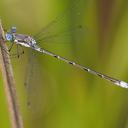United States and Canada
The head of the male is dark and the back is black. The pterothorax is black dorsally with a thin pale yellow antehumeral stripe. The metepimeron is pale with a prominent dark spot above and below metapleural carina. The thorax is pruinose ventrolaterally and sometimes entirely in older males and the abdomen is dark dorsally. There are pale yellowish ventrolateral areas with ventrolateral black streaks, particularly on 5-10. Segments 1-2, 9-10 and the ventrolateral areas of 6-8 are pruinose in older individuals. The female is generally similar to the male, but overall with the pal e areas more extensive. The posterolateral portion of the ovipositor basal plate tapers to a tooth.
Size: Total length: 32-42 mm; abdomen: 24-35 mm; hindwing: 18-23 mm
Similar Species (south-central US): Common Spreadwing (L. disjunctus) has a blue-green antehumeral stripe and Plateau Spreadwing (L. alacer) has a blue or yellow antehumeral stripe. Neither species has distinctive dark spots on metepimeron like Spotted Spreadwing
Habitat: Ponds including saline waters.
Natural History: Within its range, this is one of the latest flying damselflies. Spotted Spreadwing is found throughout all of northern North America. Females lay eggs in woody and herbaceous stems.
Distribution: Transcontinental; Southern Canada south to California and Arizona, east to Tennessee and Virginia.
Source: Abbott, J.C. 2006-2010. OdonataCentral: An online resource for the distribution and identification of Odonata. Available at OdonataCentral.
Edited by Drew Weber (9/24/2015).
